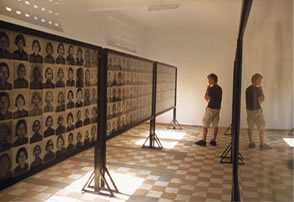A woman in Cambodia recently released more than 1,000 photographs of people imprisoned by the Khmer Rouge—the genocidal Democratic Kampuchea regime that ruled the country from 1975–79. She had worked in the regime's prison system and, fearing reprisal for her involvement, had hidden the photos. She gave the photos to the Documentation Center of Cambodia (DC-CAM), but for nearly thirty years, family members didn't know what had happened to their loved ones.
Now they know.
John D. Ciorciari, assistant professor of public policy, has served as a senior legal advisor to DC-CAM since 1999. He just finished a book manuscript on the United Nationsbacked tribunal in Cambodia and has written articles on DC-CAM's archive and the legal challenges associated with accountability and reconciliation. Much of this work helps make the archive widely accessible. But it also supports the center's ultimate goal of helping survivors heal.
Most archives of mass atrocities are funded by western countries and assembled, maintained, and staffed by a mix of foreigners and locals. In an ideal world, Ciorciari explains, governments would assemble and maintain their own archives.
"That's a foundation for liberal democracy in my view. Knowledge about the abuses of the past helps us take measures to prevent them in the future. And, hopefully, this knowledge helps deter abuses."
 |
|
Photos of people imprisoned by the Khmer Rouge on display at the Tuol Sleng Genocide Museum in Phnom Penh, Cambodia. |
Using Cambodia and other countries as case studies, Ciorciari's current research explores what roles international actors—foreign countries and NGOs—should play in assembling and managing archives in states emerging from mass atrocities. The research also addresses a number of issues around dissemination, including the role of electronic media and when and how to delimit access in the interests of individual privacy and national security.
"Assembling archives is only useful if the archives are used for something—holding people accountable or teaching children," he says. "In a society that's been inflicted with mass suffering, children should be able to look at their mother and father and aunts and uncles and understand them as survivors."
Bottom Photo: Tim Wessman / lossidesign.fi
Below is a formatted version of this article from State & Hill, the magazine of the Ford School. View the entire Fall 2012 State & Hill here.